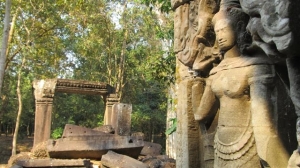The Angkor temples near Siem Reap in Cambodia are the remnants of the centre of the Khmer empire, which dominated the region from India to the south of Vietnam from about 800 to 1400 AD.
The best known and biggest, Angkor Wat is one of about 40 stone or brick complexes that have survived all these centuries. Just about everything else, including the royal palaces, was built of wood and rotted away centuries ago.
I visited Siem Reap in early February, when the weather is relatively cool. That means it’s also the busiest time of year. However it’s still possible to visit most of the monuments when they are less crowded.
The massive Angkor Wat, for example, is busy at sunrise, quieter later in the morning and early afternoon, when the many group tours head back to Siem Reap for lunch, and busier again when the tour buses return. A ‘temple mountain’, Phnom Bakheng, is packed with tourists at sunset, but was almost deserted during my early-afternoon visit. Ta Nei, shown in the photo with this post, isn’t accessible by bus and is apparently always quiet.
The Angkor temples are awe-inspiring – on a par with the pyramids of Egypt, because as well as the sheer grandeur of the temples you have the countless the carvings and bas reliefs that adorn many of them. Gigantic scale is combined with beautiful detail. As you wander through the temples successive vistas of carvings, statues, pillars and galleries are revealed.
Some temples haven’t been reclaimed from the jungle, and lie in photogenic ruins – Ta Nei is one of these overgrown monuments. Clambering over giant blocks of stone, or between huge trees that have roots entwined around walls and roofs, definitely brings out your inner Indiana Jones.
There are sobering moments too, if you pause to think about the countless streets, buildings and communities which surrounded these religious monuments, and which have completely disappeared.
And there are sobering signs of far more recent history. The genocidal Khmer Rouge only held power for four years, from 1975 to 1979, but there are many reminders of their regime and the subsequent long years of civil war.
For example at the entrance to the Bang Melea temple, across the road from a village, large signs on other side of the path proclaim that the area has been cleared of landmines.
At the spectacular Bayon temple (it was used as a location in one of the Tomb Raider films) I overhead a conversation between an American family and their guide. ‘Why is the ground bumpy?’ asked the young daughter, pointing to some grassy trenches. The guide explained the temple was used as a military base by the Khmer Rouge, who dug out the trenches to use as battle stations.
At another temple, Banteay Kdei, I chatted to a man who was selling rubbings taken from the bas-reliefs, which are on sale around many of the temples. His name is Houn Sokheng and he told me he had established a school for orphans in Siem Reap. I later looked at his website (http://www.hoacambodia.org/) and discovered that he himself is an orphan. Both of his parents were killed in the Khmer Rouge years.Tuk tuk
The advice on when to visit different temples was given to me by Pros, the tuk tuk driver I hired each day. A tuk tuk in Siem Reap is a motorbike with a detachable cabin at the back for passengers. Pros was pleasant, reliable and helpful and I would certainly recommend him to other visitors. His email address is phinravuth@yahoo.com and his mobile phone is +855 (0)9745 18555. At left is a photo of his tuk tuk.
I stayed at an establishment called the Kool Hotel (http://www.koolhotel.com/), which belied it naff name: the room was spacious, clean, comfortable and quiet and the staff were friendly and helpful. A substantial cooked breakfast was included in the price – just what you need before a day trekking around, through and over the Angkor monuments.


